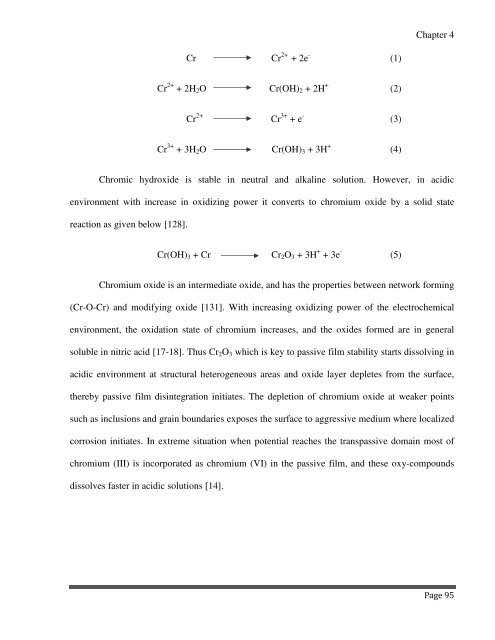CHEM02200704003 Nilamadhab Pandhy - Homi Bhabha National ...
CHEM02200704003 Nilamadhab Pandhy - Homi Bhabha National ...
CHEM02200704003 Nilamadhab Pandhy - Homi Bhabha National ...
Create successful ePaper yourself
Turn your PDF publications into a flip-book with our unique Google optimized e-Paper software.
Chapter 4<br />
Cr Cr 2+ + 2e - (1)<br />
Cr 2+ + 2H 2 O Cr(OH) 2 + 2H + (2)<br />
Cr 2+ Cr 3+ + e - (3)<br />
Cr 3+ + 3H 2 O Cr(OH) 3 + 3H + (4)<br />
Chromic hydroxide is stable in neutral and alkaline solution. However, in acidic<br />
environment with increase in oxidizing power it converts to chromium oxide by a solid state<br />
reaction as given below [128].<br />
Cr(OH) 3 + Cr Cr 2 O 3 + 3H + + 3e - (5)<br />
Chromium oxide is an intermediate oxide, and has the properties between network forming<br />
(Cr-O-Cr) and modifying oxide [131]. With increasing oxidizing power of the electrochemical<br />
environment, the oxidation state of chromium increases, and the oxides formed are in general<br />
soluble in nitric acid [17-18]. Thus Cr 2 O 3 which is key to passive film stability starts dissolving in<br />
acidic environment at structural heterogeneous areas and oxide layer depletes from the surface,<br />
thereby passive film disintegration initiates. The depletion of chromium oxide at weaker points<br />
such as inclusions and grain boundaries exposes the surface to aggressive medium where localized<br />
corrosion initiates. In extreme situation when potential reaches the transpassive domain most of<br />
chromium (III) is incorporated as chromium (VI) in the passive film, and these oxy-compounds<br />
dissolves faster in acidic solutions [14].
















